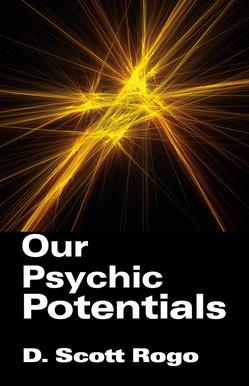
|
|
Our Psychic Potentials
by D. Scott Rogo
Trade Paperback, 184 Pages
$15.95, ISBN: 1933665084
Genre(s):
Paranormal
Psychic Abilities
Parapsychologists have uncovered irrefutable evidence that psychic abilities -- including telepathy, precognition, and psychokinesis - exist. But they are not “gifts” in any sense of the word. They are potentials. And as potentials, they are something we all inherently possess and can develop. The only problem is: how can we tap and use these abilities reliably?
In Our Psychic Potentials, D. Scott Rogo presents some very specific strategies -- some known about for hundreds of years, others recently discovered - for accessing our psychic potentials. These psychic development techniques involve dreaming, mental imagery, relaxation, suggestion, and feedback. Called “open minded,” “frank,” and “refreshing” by readers, this step-by-step guide to self-testing and psychic training also examines the scientific evidence that our psychic abilities can indeed be developed and used on demand.
About the Author: D. Scott Rogo (1950-1990) was one of the most widely respected writer-journalists covering the field of parapsychology, as well as an active scientific investigator. Educated at the University of Cincinnati and San Fernando Valley State College, Rogo held a unique position in parapsychology and made many contributions to the field that deserve recognition. He served as a visiting researcher at the Psychical Research Foundation, then in Durham, North Carolina, and at the Division of Parapsychology and Psychophysics of the Maimonides Medical Center in Brooklyn, New York. He published papers on ESP in refereed parapsychological journals and was active in field investigations of hauntings and poltergeists. Rogo was also a leading authority on the history of psychical research; the breadth of his historical knowledge of the field was unsurpassed. Over the course of more than two-dozen published books, Rogo sought to broaden the range of topics worthy of paranormal research.
Visit the D. Scott Rogo Collection on Anomalist Books
EXCERPT FROM the Introduction:
ESP is not a rare one-shot phenomenon in which a piece of information is transmitted. It seems to be a dynamic function transmitting all the time below the threshold of waking consciousness. This simple fact holds the key for those of us who are concerned with whether or not psychic ability can be learned and developed:
Learning to be psychic does not entail sending the mind "out" someplace and bringing information back to the brain and body. ESP is not a process like radar in which we must be alert for any significant incoming signals. It is a process of going deep within the self and retrieving information that is already there.
I suggest you reread the above paragraph several times until this concept is totally understood. It is the brick from which the rest of this book will be built.
The really ironic thing is that, while this model and its implications have evolved relatively recently within academic parapsychology, gifted psychics have long known that certain strategies help them gain access to their powers. Parapsychologists today are only discovering what many psychics have known for years! To be psychic, you need only go deeply within yourself.
The researcher who first discovered that many psychics habitually use such strategies was Rhea White, who carried out her work while she was a research associate at the American Society for Psychical Research in New York in the 1960s. Her interest in this whole area of study was piqued during some conversations she had with the wife of one of the society's donors, an intelligent woman, very psychic, who used a standard formula to tap her ESP potentials consisting of muscular relaxation, the generation of mental imagery, and self suggestion. This led Ms. White to study the autobiographical accounts of the famous psychics of the past and present. She delved into the early Duke University work where Dr. J. B. Rhine had discussed the strategies his most gifted laboratory subjects had employed; the deeply introspective and insightful writings of Craig Sinclair (the wife of the famous novelist Upton Sinclair), who was also a remarkably talented psychic; Rene Warcollier, one of France's greatest parapsychologists who eventually became his own best subject; and many others. Her final report on these studies, which was issued in 1964, was an eye opener. While each of the psychics she studied had his or her own personal idiosyncracies, White found that they all tended to use similar techniques when wishing to use their ESP powers.
The psychics tended to go about their work step by step; they tended to begin by physically relaxing themselves. White reported in her study that "the early reports place a great deal of emphasis on achieving a state of deep mental relaxation. Deliberate attempts [were] made to still the body and mind, and these techniques [were] in most cases incorporated into a kind of ritual." This step was apparently very important since the psychics would often spend several minutes relaxing by the use of standard relaxation exercises. They then tended to engage in some sort of activity which preoccupied the conscious mind and sort of "put it out of the way," but without entering into a trance. Some psychics were inclined to focus passively on a mental image. The next step was less concrete. The psychics would give themselves a mental command, almost like an autohypnotic injunction, for ESP to surface into consciousness. This entailed waiting until the needed information indeed surfaced. The mediating vehicle for the information was usually a mental image, an intuition, or just a sudden grasp of the material needed or requested.
These techniques may seem very simple, but they are more complex than might meet the eye. It took White some sixteen pages of quotes and commentaries to set out the particulars of these strategies. I won't go into her findings in detail at this time, since I will be alluding to her study and evidence in upcoming chapters. The most important thing to remember for now is that these strategies, taken as a whole, represent a comprehensive system for gaining access to the psychic sense. They are not merely convenient and idiosyncratic mental tricks the psychics chanced upon…
TABLE OF CONTENTS
preface
introduction: learning to be psychic
1. the role of dreaming
2. the role of mental imagery
3. the role of relaxation
4. the role of suggestion
5. the role of feedback
conclusion: the truth about psychic development courses
appendix I: judging free response material
appendix II: ESP and drugs
index |



















